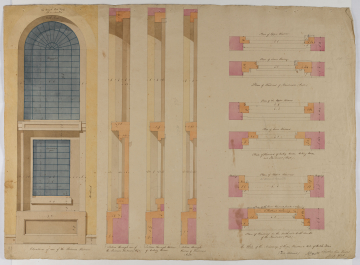
Browse
Reference number
Purpose
Aspect
On the left-hand side is an elevation of a transomed window set within a relieving arch. A recessed panel is at the bottom, and above is a sill and a square casement window with transoms divided by two mullions. Above is a recessed panel forming a transom. The upper window has an arched top. The square portion is transomed and is divided by four mullions and the arched top sees these mullions meet to form a fan
In the middle are shown three versions of different windows for the church. In form these are nearly identical to the bottom in having masonry faced with Portland stone to form the panel, more Portland stone in the middle to form the sill and at the top of the window surround. A difference with the section on the left-hand side is a strip of Portland stone from the panel to the sill. Each section illustrates a differing thickness, with the section for the left-hand side being the thickest, and the right-hand side being the thinnest
Scale
Inscribed
Signed and dated
- January 1826
Lincolns Inn Fields / Jany 1826._
Medium and dimensions
Hand
Watermark
Level
Sir John Soane's collection includes some 30,000 architectural, design and topographical drawings which is a very important resource for scholars worldwide. His was the first architect’s collection to attempt to preserve the best in design for the architectural profession in the future, and it did so by assembling as exemplars surviving drawings by great Renaissance masters and by the leading architects in Britain in the 17th and 18th centuries and his near contemporaries such as Sir William Chambers, Robert Adam and George Dance the Younger. These drawings sit side by side with 9,000 drawings in Soane’s own hand or those of the pupils in his office, covering his early work as a student, his time in Italy and the drawings produced in the course of his architectural practice from 1780 until the 1830s.
Browse (via the vertical menu to the left) and search results for Drawings include a mixture of Concise catalogue records – drawn from an outline list of the collection – and fuller records where drawings have been catalogued in more detail (an ongoing process).

